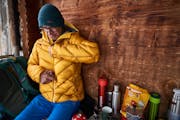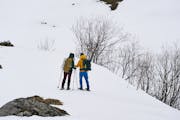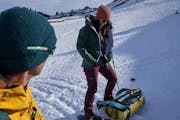Ruedi Thomi
On a snowshoe hike in Toggenburg, you can discover the Churfirsten region on new trails. Purchaser Harry presents a tour and tells you what equipment you need for a snowshoe tour.
There is simply no need for superlatives when it comes to Alp Sellamatt, which stands around 1,500 metres high with the Alpstein region to the north and the seven Churfirsten peaks with their iconic silhouettes to the south. All of this offers one breathtaking view after the other. You’ll have your eyes fixed on the striking peaks of Chäserrugg (2,260 m), Hinderrugg (2,306 m), Schibenstoll (2,234 m) Zuestoll (2,234 m), Brisi (2,277 m), Frümsel (2,266 m) and Selun (2,204 m) as you slip into your snowshoes at the Selamatt lift station.
Sellamatt-Zinggen trail
The Sellamatt-Zinggen trail makes a big loop around Alp Sellamatt – a rambling high plateau that is located halfway between the valley and summits of the Churfirsten mountain range. Once the snow has wrapped the stunning landscape in a crystalline blanket of white, a magnificent sense of serenity settles over the area. The only sound is the wind that rustles through the ancient spruce trees, the cawing nutcrackers wrangling for fir cone seeds or the distinctive whistles of alpine chough searching for nourishment at lower elevations in mid-winter.
The right shoes for snowshoeing
Snowshoes are secured to your boots with straps or loops. In principle, therefore, you could venture out in a normal hiking boot with a sturdy sole. These should be at least ankle-high and waterproof, however. Otherwise you’ll soon feel the damp seeping in and you’ll end up with wet feet. Special winter models are cut higher, feature a thick lining, and help keep your toes nice and warm.
If you want to stop snow from getting into your shoes, we recommend wearing trousers with a snow guard or gaiters. And if you think even a winter shoe might not be warm enough, why not add an insulation sole? But don’t overdo it because you don’t want your feet to break out in a sweat when the going gets tough.
To the packing listYour packing list for snowshoeing

Outdoor clothing in layers
Good old layered clothing is still your best bet. Those steep climbs in deep snow will no doubt make you sweat. This makes breathable clothing that allows moisture to escape all the more important. And when it’s time for a snack or lunch, we recommend changing into a spare shirt so you don’t catch a cold.

Poles for better grip
Trekking or ski poles help you keep your balance. Many models allow you to swap the rubber tips for wide plates and these can be used in deep snow. This saves you energy and provides more stability, especially when tackling steep sections or traverses.

Good sun protection in winter
Never underestimate the power of the sun in the mountains. Even if it’s slightly overcast, you run the risk of sunburn and the light reflections are bad for your eyes. Never forget to pack your sunglasses and sun cream.

Greater safety in the event of an avalanche
And very important: avalanche transceivers, avalanche shovels and probes are essentials on every snowy adventure in exposed terrain. It’s also a good idea to pack a first aid kit and survival blanket. At the end of the day, you can only be rescued if you are found. That’s why you should always go in pairs. It’s safer and more fun.
Share the articleSnowshoe hike in Toggenburg: To Alp Sellamatt
- Free shipping from CHF 99
(With the TransaCard always free of charge)
- Secure payment with Twint, Visa and more
- 14 days cancellation right





